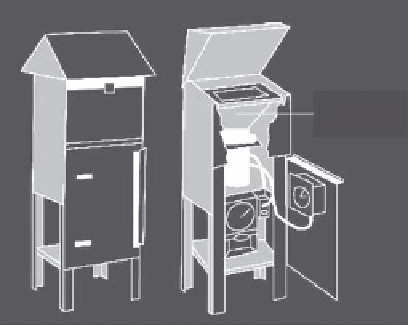Environmental Engineering Reference
In-Depth Information
occupants at various locations. In private residences, air samples should be collected from
all the floors, including the basement, and outdoors.
For comparison purposes, indoor samples collected from commercial or industrial set-
tings should be collected during normal operating hours and again during times when
the facility or locations are not in operation and occupied. To ensure a robust sample—one
that is representative of the conditions being tested and minimizes other influences—
samples should be collected for at least 1 h, and not more than 8 h.
Sample collection techniques vary depending on the analytical method(s) being used,
and must conform to the specific sample collection method. Some methods also specify
that duplicate samples must be collected. Indoor air sampling is either conducted on indi-
viduals or at stationary locations. Sampling conducted on individuals is either passive or
by a sampler attached to a pump that pumps air through a filter or sampling media. This
process captures potential contaminants and stores them until analysis can be conducted.
To be as representative as possible, indoor air samples are usually collected within the
breathing zone between 1 and 2 m (3 and 6 ft) above the floor.
4.3.5.2 Outdoor Air Sampling
Outdoor air sampling for particulates is conducted using high volume air sampling equip-
ment as depicted in Figure 4.29 (USEPA 1998). The ambient air sampling device shown
pumps air from all directions across a 18 × 23 cm (7 × 9 in.) exposed filter inside the shel-
ter at flow rates ranging from 1.1 to 1.7 m
3
(39-60 ft
3
) of air per minute. The roof design
depicted in Figure 4.30 of the shelter is a standard design acting as a plenum above the
filter to permit the free flow of air into the plenum space. The sizes of particles collected
using the sampler range from 0.3 μ to as large as 25-50 μ in aerodynamic diameter, and are
dependent upon wind direction and speed (USEPA 2008).
Filters used for collecting outdoor air sampling for particulates are composed of either
glass or cellulose fibers. Glass fiber samples have been extensively used, and cellulose
fiber filters are commonly used when sampling for heavy metals. One drawback to cellu-
lose fibers is their potential to increase the potential for adsorption of water and enhance
artifact formation of nitrates and sulfates on the filter. The filters are kept in a clean and
sterile environment prior to sampling at a constant temperature and a relative humidity of
approximately 3%, and are precisely weighed (USEPA 1998). After the sample is collected,
several parameters must be recorded, including
High volume
sampler
FIGURE 4.29
Outdoor particulate air sampler. (From United States
Environmental Protection Agency,
List of Designated
Reference and Equivalent Methods for Air Sampling
,
United States Environmental Protection Agency
National Exposure Research Laboratory, Washington,
DC, 2008.)

Search WWH ::

Custom Search